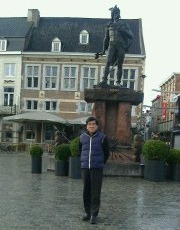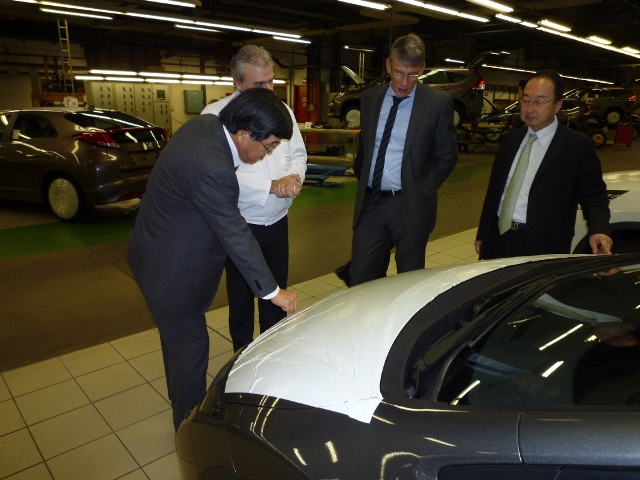|
Belgian History, the suffering of a multilingual country (No.5)
4th January, 2013
Happy New Year. Though there are a lot of political, economic and diplomatic difficulties, I hope that this year will be a good year, full of hope.
As two and half months have passed since my arrival to Brussels, I have settled down a bit in my daily life. During the New Year’s holidays, I was absorbed in reading books about Belgium every day and night. They are interesting. One of them is “Histoire de la Belgique” written by the Belgian historian Georges-Henri Dumont. The beginning of this thick book introduces the evaluation of the Belgians by Julius Caesar in his "Gallic Wars". It says that “the Belgians are the bravest among all Gallic people”. It is true that Caesar struggled with the Eburons in the north (the ancestors of the Belgians?) over 5 years in the final battle. It is an interesting story that shows the Belgians’ spirit.
< Wallonia and Flanders >
Belgium is a multilingual country. The Dutch region is in the north of Belgium and the French region is in the south. German is spoken in small towns adjacent to the German border. The French speaking and Dutch speaking area are mixed in Brussels. It seems strange because I come from Japan in which one language is spoken. We need to look at the history to find out why this situation exists in Belgium.
Belgium was originally located on the border of the Romance world and the Germanic world in the west of Europe. If we go back to the 12-13th century, Belgium was a non-united “lowland area” in which local lords ruled individually (there was no nation). However, a first step towards a “unified” Belgium, Netherlands and Luxembourg was achieved by the Duke of Burgundy who ruled over the Low Countries from the middle of the 14th century. Belgium was incorporated into the Austrian Hapsburg family through marriage and ruled by the Holy Roman Empire. Belgium became the territory of the Spanish Hapsburg by inheritance from the middle of the 16th century on. A big turning point for Belgium came later as Calvinist Christianity (Protestant) spread throughout the north of the “Low Countries” during the Reformation that swept across Europe. The north of the “Low Countries” fought against the Catholic Spanish Empire and became independent as the Netherlands. The south of the “Low Countries” (Belgium), which was mostly Catholic, remained under Spanish rule. After that, conflicts between countries about inheritance of the throne continued at the time of Louis XIV and the south became the territory of the Austrian Hapsburg family again. When the French Revolution occurred at the end of the 18th century, French citizen soldiers invaded the south which was completely incorporated into France under Napoleon rule. After Napoleon’s defeat, it was decided at the post-war Convention of Vienna that the area known as Belgium today belonged to the Netherlands. It was 1815, 15 years before the independence of Belgium. Well, it is so complex.
I understand that Belgium and the Netherlands, which were originally considered as “one area”, were separated due to the difference in religions, not due to the difference in languages. As a result, two languages coexisted in one single country when the Kingdom of Belgium became independent in 1830. In addition, as only French was the official language in the Constitution, which was enacted after the independence, the Dutch-speaking people in the northern half of the country were dissatisfied. Though at the end of the 19th Century a compromise was reached by which Dutch became an official language too, perfect equality was not achieved. This sparks conflicts, continuing to this day. Now in the 21st century, separate administrations (federal system) have been established according to the language and “the actual separation”, also linked to the economic disparity, tends to advance further. The French-speaking area is called “Wallonia” and the Dutch-speaking area is called “Flandres” (In Dutch Vlaanderen), in English “Flanders”. After World War I, German territory was ceded from Germany to Belgium and a complicated multilingual country came into being. From my opinion as a foreigner, this multilingual situation is precisely the uniqueness of Belgium and I hope that Belgium will advance greatly as a united nation by making use of this uniqueness. Well, well, what will the future bring for this country…
< The first Belgian to have visited Japan >
 At the end of last year, I visited Tongeren (Tongres in French), a little town in the northeast of Belgium, and 87 km from Brussels. Although the town has nearly 30.000 inhabitants, the atmosphere is very rural and ancient. That should indeed be the case, given the fact that Tongeren was known as the central city in northern Gallia in Roman times. In the town’s main square, there is a statue of the legendary hero Ambiorix, who fought fiercely against Caesar. The Basilica of Our Lady, built in the Middle Ages (Kamakura-Muromachi period in Japan), stands in all its majesty right next to this statue. In the Treasury of the Cathedral, you can see several religious relics, dating back to the 6th century. At the end of last year, I visited Tongeren (Tongres in French), a little town in the northeast of Belgium, and 87 km from Brussels. Although the town has nearly 30.000 inhabitants, the atmosphere is very rural and ancient. That should indeed be the case, given the fact that Tongeren was known as the central city in northern Gallia in Roman times. In the town’s main square, there is a statue of the legendary hero Ambiorix, who fought fiercely against Caesar. The Basilica of Our Lady, built in the Middle Ages (Kamakura-Muromachi period in Japan), stands in all its majesty right next to this statue. In the Treasury of the Cathedral, you can see several religious relics, dating back to the 6th century.
I paid a visit to this town for another reason though. Tongeren is the birthplace of the Jesuit missionary Theodore Mantels, who was the first Belgian to set foot on Japanese soil. In 1588, he disembarked in Nagasaki at the age of 28 and engaged in missionary work in the area of Hirato for nearly 4 years. When Father Mantels reached Japan, 40 years after Francis Xavier planted the seeds of the Gospel in Japan, Hideyoshi Toyotomi, then ruler of Japan had already issued the Anti-Christianity Edict. Oppressed by the feudal lord of Hirato, Father Mantels left Japan with disappointment in 1592. He died the following year in Malacca. Standing in the main square of Tongeren, I thought about where the religious zeal of the young Mantels might have come from. Being born in 1560, the year around that the Basilica of Our Lady was completed after nearly 400 years, I felt that it might have been his destiny. The first encounter between Japan and Belgium was an unfortunate one, but it turned out to be the starting point of a long friendship between the two countries. Finding slight relief in this, my visit to Tongeren ended.
< Company Visit No. 3: Honda >
 Finally, I would like to say a few words about Honda, which I visited end of last year. The Honda Belgium Factory was founded in Aalst (29km to the west of Brussels, population: 80.000) in 1962 as the first overseas factory by Honda Motor Company Ltd. Sixteen years later, Honda Europe was established on the outskirts of Ghent. In the beginning, the factory in Aalst (185 workers) produced mini-motorcycles called “mopeds”, like a bicycle with an electric motor. Several transitions later, the factory has specialized in the packaging of large parts, the coating of bumpers for repair, etc. On the other hand, the factory in Ghent (580 employees) serves as a European hub for small spare parts and also carries out the final inspection of cars prior to their shipment. The information system for all Europe is managed here as well. Both factory grounds are huge because of the storage warehouses build therein. The factory in Ghent is even affiliated to a special loading port by making use of the canal. It truly is a “logistics center”. Finally, I would like to say a few words about Honda, which I visited end of last year. The Honda Belgium Factory was founded in Aalst (29km to the west of Brussels, population: 80.000) in 1962 as the first overseas factory by Honda Motor Company Ltd. Sixteen years later, Honda Europe was established on the outskirts of Ghent. In the beginning, the factory in Aalst (185 workers) produced mini-motorcycles called “mopeds”, like a bicycle with an electric motor. Several transitions later, the factory has specialized in the packaging of large parts, the coating of bumpers for repair, etc. On the other hand, the factory in Ghent (580 employees) serves as a European hub for small spare parts and also carries out the final inspection of cars prior to their shipment. The information system for all Europe is managed here as well. Both factory grounds are huge because of the storage warehouses build therein. The factory in Ghent is even affiliated to a special loading port by making use of the canal. It truly is a “logistics center”.
|

